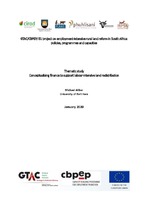| dc.description.abstract | This paper seeks to provide an overview and understanding of how South Africa’s smallholder farmers and small-scale black commercial farmers (‘SFs & SSBCFs’) presently finance their agricultural operations (excluding land acquisition), with a view to identifying where the current system could be improved so as to support an employment-intensive land reform premised on these types of farmers. As such, the paper seeks to identify what are the main sources of loan and grant finance to farmers, and to indicate what is known about the reach and effectiveness of these various institutions / products / programmes. The paper also briefly considers what we know about self-financing, while also touching on sundry other financial services and issues, in particular input subsidies, e-money and insurance. While doing so, the paper traces recent policy discussions and debates regarding the provision of agricultural finance. The most salient policy development in recent years is the emergence of a consensus that grant finance should be reduced in favour of loan finance, which has been followed by an abortive attempt to introduce ‘blended finance’.
While it is difficult to develop a precise picture of the funding landscape on account of lack of or contradictory data, and the current flux within the sector, some patterns do emerge.
First, it is indeed the case that grant finance is almost on a par with loan finance, however there is an evident division of labour whereby loan finance is channelled more towards larger-scale black farmers, and the majority of beneficiaries of grant finance are towards the subsistence end of the spectrum. (Having said this, while subsistence producers are more numerous as beneficiaries of grant funding, it is not clear that, collectively, they receive most of this funding.) There is a logic to this state of affairs in that, to the extent government renders material support to subsistence farmers, it would not make sense for it to be in the form of loans unless the idea is for them to commercialise. On the other hand, much of the support to subsistence producers in principle is in fact meant to promote commercialisation, but appears unable to do so, suggesting that at least some of these grant programmes are ill-conceived. Moreover, among commercially oriented smallholder farmers, there is a woeful absence of both grant and loan finance, and arguably it would make sense to upscale the loan finance aspect.
Where SFs & SSBCFs are concerned, a particular problem is the absence of short-term production finance. MAFISA had tried to fill the vacuum, but at present is operating at an extremely low level and, it has been argued, its management challenges have not warranted recapitalisation. The Land Bank, meanwhile, has struggled to do business at scale with SFs & SSBCFs, and has struggled in particular to provide production credit, especially unsecured production credit. Of course, these concerns extend well beyond land reform.
Overall, the paper demonstrates that, while there are many financing tools in place to support black farmers in general as well as land reform beneficiaries in particular, their collective footprint is modest-to-small relative to current needs, and grossly inadequate relative to the needs implied by a significantly scaled up redistribution programme aiming to support meaningful numbers of SF and SSBCF beneficiaries. | en_US |

